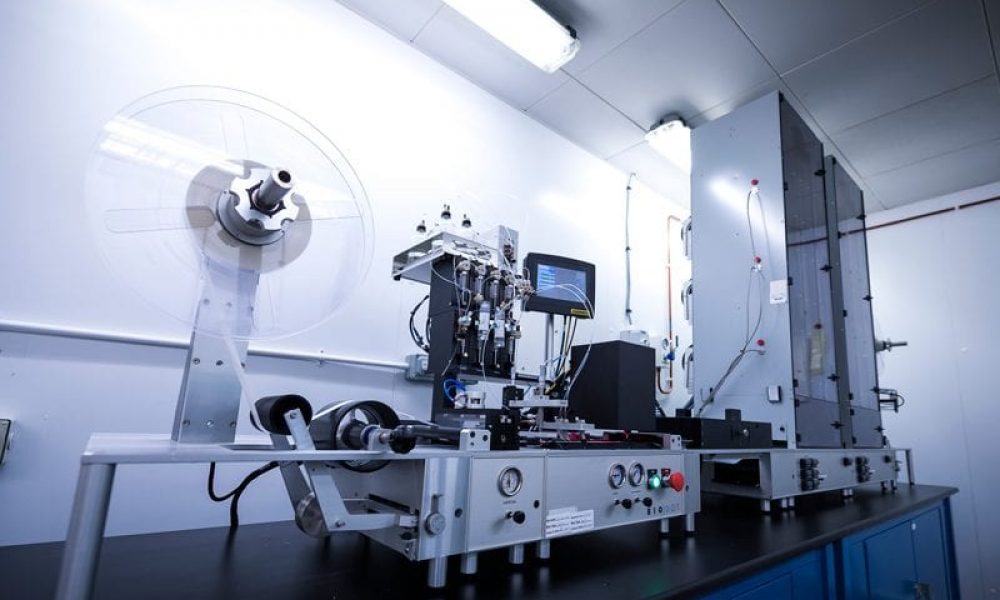There are three key elements to manufacturing lateral flow assays that enable consistently accurate and reproducible results:
- Expertise
- Experience
- Automation
Expertise ensures that an assay is optimised and scaled-up efficiently for routine manufacturing; experience means tried and tested processes and procedures are utilised, regulatory considerations are taken into account, and market requirements are established and adhered to; and automation ensures that the devices developed and manufactured provide accurate results time and time again, with excellent inter and intra-batch reproducibility.
Why automated lateral flow manufacturing improves rapid test accuracy
Once an assay has progressed through the feasibility and optimisation phases of an assay development project, scale-up to manufacture is the next process prior to routine manufacture. This is where the manufacturing specifications are set in order to manage large batch sizes.
 Lateral flow assays can be manufactured and assembled by hand; however, the cost implications, batch sizes and assay reproducibility of this manual process can drive the decision to switch to automation.
Lateral flow assays can be manufactured and assembled by hand; however, the cost implications, batch sizes and assay reproducibility of this manual process can drive the decision to switch to automation.
At Abingdon Health we use the following automated lateral flow manufacturing equipment to ensure assay accuracy and reproducibility:
Contact and non-contact tips for dispensing
- Equipment is set-up to dispense in accordance with pre-set parameters devised by assay specialists during development.
- Extensive testing during development will dictate which method will be utilised to ensure robustness and reproducibility.
Reel-to-reel web handling system for reagent spraying
- Precise deposition of reagents onto the nitrocellulose membrane and conjugate release pad is essential for accurate results, particularly in the case of quantitative assays. Without this highly precise equipment, the assay performance could be compromised and fail to achieve the required specifications.
- Abingdon Health’s reel-to-reel system allows up to 5 lines to be sprayed simultaneously, reducing the amount of handling of the membrane. Drying towers ensure constant conditions are maintained for the complete length of the sprayed materials, contributing to assay reproducibility.
Auto-laminator for assembly of membranes and other components
- Once membranes and conjugate release pads have been sprayed with the necessary reagents they need to be applied to a backing card. During this process reels of membrane, conjugate pad, wicking pads and other assay components are laid sequentially onto a reel of backing card. The alignment of these materials is critical to the functionality of the assay and using dedicated equipment such as the auto-laminator ensures reproducibility and minimises batch failure.
Accurate, high-throughput lateral flow cassette assembly
- Assembling test strips in to cassettes needs to be done accurately while coping with high-volume demand. State-of-the-art, automated cassette assembly needs to be used and needs to be capable of assembling different lateral flow test variants. High quality is maintained with vision guided robot operation and inspection and ensures dipsticks are cut to exact specifications and placed in cassettes accurately. Abingdon Health's lateral flow manufacturing video shows this equipment working.
Automated dispensing of buffers
- For some applications the use of a precise volume of buffer, whether a dilution buffer or a chase buffer, is essential to the assay design. The ability to dispense multiple batches of a buffer using automation ensures accuracy and removes the potential issue of user error.
Finding a partner that has access to equipment such as above can be a determining factor when choosing a lateral flow assay manufacturer.
To learn more about Abingdon Health’s ISO 13485 and GMP compliant automated lateral flow manufacturing capabilities, please contact us via our website or call +44 (0) 1904 406050.

